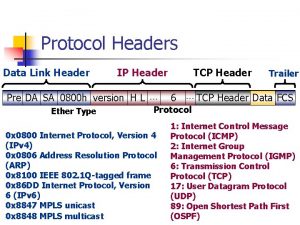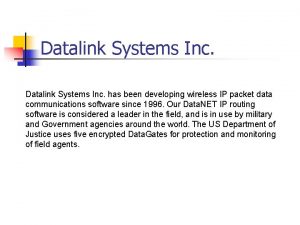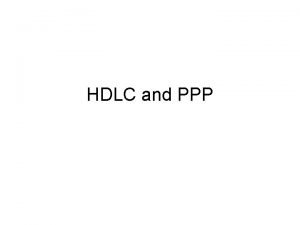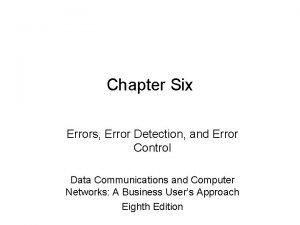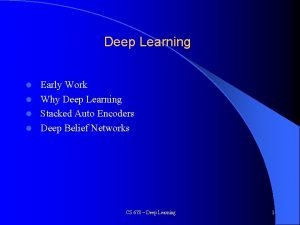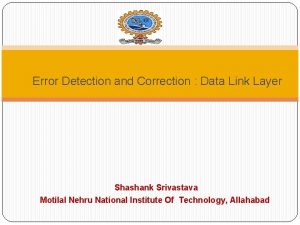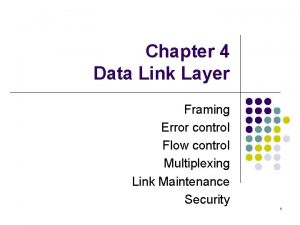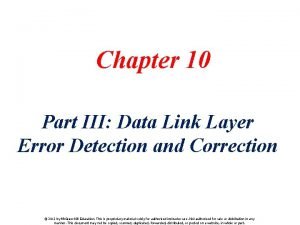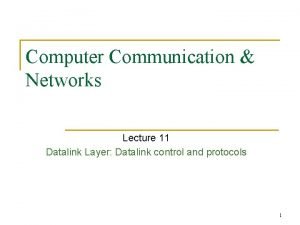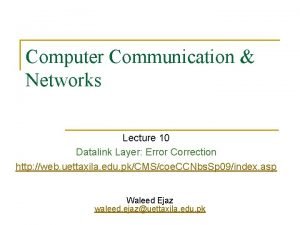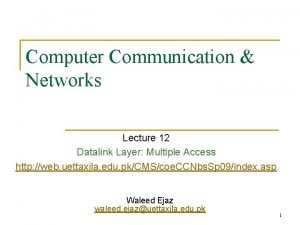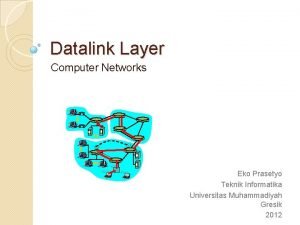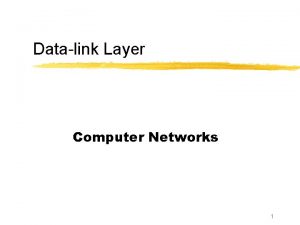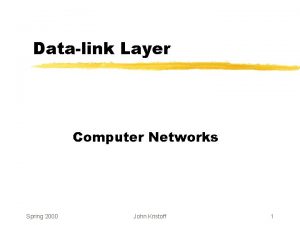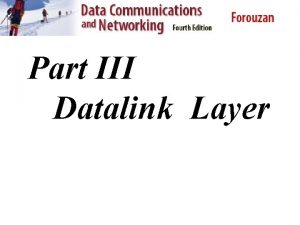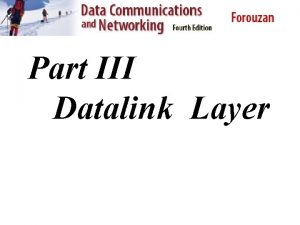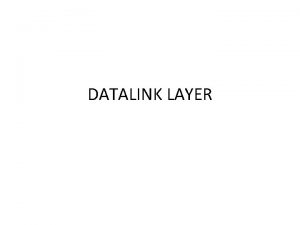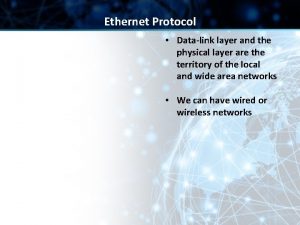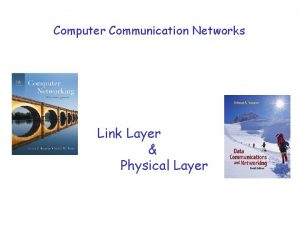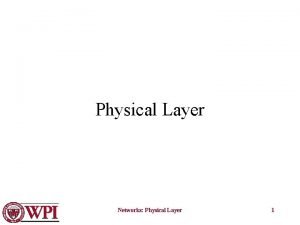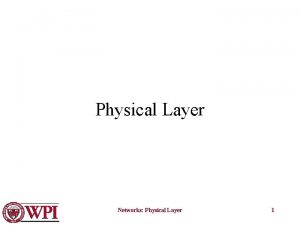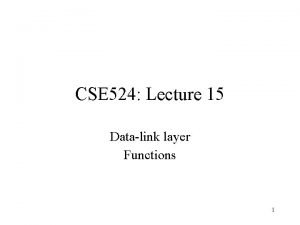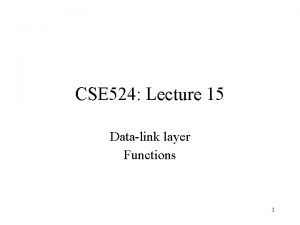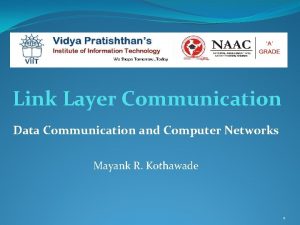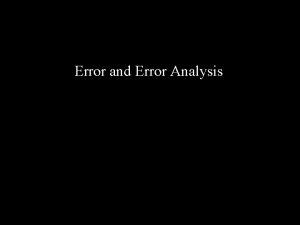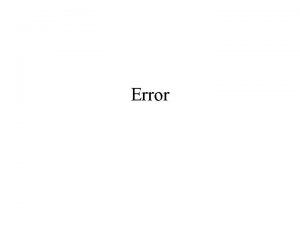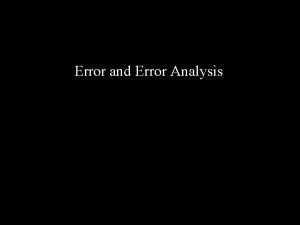Computer Communication Networks Lecture 9 Datalink Layer Error

































- Slides: 33

Computer Communication & Networks Lecture 9 Datalink Layer: Error Detection

Data Link Layer

Data Link Layer Topics to Cover Error Detection and Correction Data Link Control and Protocols Multiple Access Local Area Networks Wireless LANs

Error Detection n Why we need it ? q n To avoid retransmission of whole packet or message What to do if error detected ? q Discard, and request a new copy of the frame: n q explicitly or implicitly Try to correct error, if possible

Note Data can be corrupted during transmission. Some applications require that errors be detected and corrected.

Types of Errors n Single Bit Error q In a single-bit error, only 1 bit in the data unit has changed. n Burst Error q A burst error means that 2 or more bits in the data unit have changed.

Redundancy n To detect or correct errors, we need to send extra (redundant) bits with data.

Error Detection

Simple Parity Check n A simple parity-check code is a single-bit error-detecting code in which n = k + 1.

Example n Let us look at some transmission scenarios. Assume the sender sends the dataword 1011. The codeword created from this dataword is 10111, which is sent to the receiver. We examine five cases: 1. No error occurs; the received codeword is 10111. The syndrome is 0. The dataword 1011 is created. 2. One single-bit error changes a 1. The received codeword is 10011. The syndrome is 1. No dataword is created. 3. One single-bit error changes r 0. The received codeword is 10110. The syndrome is 1. No dataword is created.

Example (contd. ) 4. An error changes r 0 and a second error changes a 3. The received codeword is 00110. The syndrome is 0. The dataword 0011 is created at the receiver. Note that here the dataword is wrongly created due to the syndrome value. 5. Three bits—a 3, a 2, and a 1—are changed by errors. The received codeword is 01011. The syndrome is 1. The dataword is not created. This shows that the simple parity check, guaranteed to detect one single error, can also find any odd number of errors.

Performance n A Simple parity check can detect all single-bit errors. It can detect burst errors only if the total number of errors in each data unit is odd.

Two-dimensional Parity-check Code

Two-Dimensional Parity 0 1 0 0 0 1 1 0 1 1 0 0 0 1 1 0 1 0 0

Example Suppose the following block is sent: 10101001 00111001 1101 11100111 1010 n However, it is hit by a burst noise of length 8, and some bits are corrupted. 10100011 10001001 1101 11100111 1010 n n When the receiver checks the parity bits, some of the bits do not follow the even-parity rule and the whole block is discarded. 10100011 10001001 1101 11100111 1010

Performance n 2 D parity check increases the likelihood of detecting burst errors. As we have seen in the example given in the previous slide, a redundancy of n bits can easily detect a burst error of n bits. There is, however, one pattern of errors that remains un-detectable. If 2 bits in one data unit are damaged and 2 bits in exactly in the same positions in another data unit are also damaged, the checker will not detect an error.

Cyclic Redundancy Check • Cyclic Redundancy Check (also called polynomial code) • Based on modulo-2 binary division • No carries (because it's modulo-2) • Subtraction is equivalent to XOR

Division in CRC encoder

Division in the CRC decoder for two cases

A polynomial to represent a binary word

CRC division using polynomials

Performance n n n In a cyclic code, those e(x) errors that are divisible by g(x) are not caught. If the generator has more than one term and the coefficient of x 0 is 1, all single errors can be caught. A generator that contains a factor of x + 1 can detect all odd-numbered errors.

Performance (contd. ) n n n All burst errors with L ≤ r will be detected. All burst errors with L = r + 1 will be detected with probability 1 – (1/2)r– 1. All burst errors with L > r + 1 will be detected with probability 1 – (1/2)r.

Example Which of the following g(x) values guarantees that a single-bit error is caught? For each case, what is the error that cannot be caught? a. x + 1 b. x 3 c. 1 Solution a. No xi can be divisible by x + 1. Any single-bit error can be caught. b. If i is equal to or greater than 3, xi is divisible by g(x). All single-bit errors in positions 1 to 3 are caught. c. All values of i make xi divisible by g(x). No single-bit error can be caught. This g(x) is useless.

Properties of Good Polynomials n n A good polynomial generator needs to have the following characteristics: It should have at least two terms. The coefficient of the term x 0 should be 1. It should have the factor x + 1.

Table 10. 7 Standard polynomials

Summary n n n CRC can detect all burst errors that affect an odd number of bits. CRC can detect all burst errors of length less than or equal to the degree of polynomial. CRC can detect, with a very high propability, burst errors of length greater than the degree of polynomial.

Checksum Example: IP header 3. The data unit is divided into k sections, each of n bits All sections are added using 1’s complement The sum is complemented 4. The checksum is sent with data 1. 2.

Checksum: Sending Suppose the following block of 16 bits is to be sent using a checksum of 8 bits. 10101001 00111001 The numbers are added using one’s complement 10101001 00111001 ------Sum 11100010 n Checksum 00011101 (Take 1’s complement of Sum) n The pattern sent is 10101001 00111001 00011101

Checksum: Receiving Now suppose the receiver receives the pattern sent and there is no error. 10101001 00111001 00011101 n When the receiver adds the three sections, it will get all 1 s, which, after complementing, is all 0 s and shows that there is no error. 10101001 00111001 00011101 Sum 1111 Complement 0000 means that the pattern is OK.

Checksum: Error A burst error of length 5 that affects 4 bits. 101011111001 00011101 n When the receiver adds the three sections, it gets 101011111001 00011101 Partial Sum 1 11000101 Carry 1 Sum 11000110 => Complement 00111001 !!!? ?

Readings n Chapter 10 (B. A Forouzan) q q Section 10. 1, 10. 3, 10. 4 (Cover only those contents which are related to topics covered in class)

 Layer data link
Layer data link Vc vs datagram
Vc vs datagram Backbone networks in computer networks
Backbone networks in computer networks Pi performance equation syntax
Pi performance equation syntax Udp protocol
Udp protocol Datalink systems
Datalink systems Switching in data link layer
Switching in data link layer Osi model acronym
Osi model acronym Network layer design issues
Network layer design issues Elementary data link protocols
Elementary data link protocols Hdlc and ppp
Hdlc and ppp Network layer design issues
Network layer design issues Error detection in computer networks
Error detection in computer networks Error control in computer networks
Error control in computer networks Error detection in computer networks
Error detection in computer networks Transmission error in computer networks
Transmission error in computer networks 01:640:244 lecture notes - lecture 15: plat, idah, farad
01:640:244 lecture notes - lecture 15: plat, idah, farad A link layer protocol for quantum networks
A link layer protocol for quantum networks Greedy layer wise training of deep networks
Greedy layer wise training of deep networks Fig 19
Fig 19 Path of food from mouth to anus
Path of food from mouth to anus Secure socket layer and transport layer security
Secure socket layer and transport layer security Presentation layer functions
Presentation layer functions Secure socket layer and transport layer security
Secure socket layer and transport layer security Secure socket layer and transport layer security
Secure socket layer and transport layer security Secure socket layer and transport layer security
Secure socket layer and transport layer security Layer 2 e layer 3
Layer 2 e layer 3 Layer-by-layer assembly
Layer-by-layer assembly Layer 2 vs layer 3 bitstream
Layer 2 vs layer 3 bitstream Error detection and correction in data link layer
Error detection and correction in data link layer Error control in data link layer
Error control in data link layer Block coding in data link layer
Block coding in data link layer Type of errors in statistics
Type of errors in statistics Type 2 vs type 1 error
Type 2 vs type 1 error




